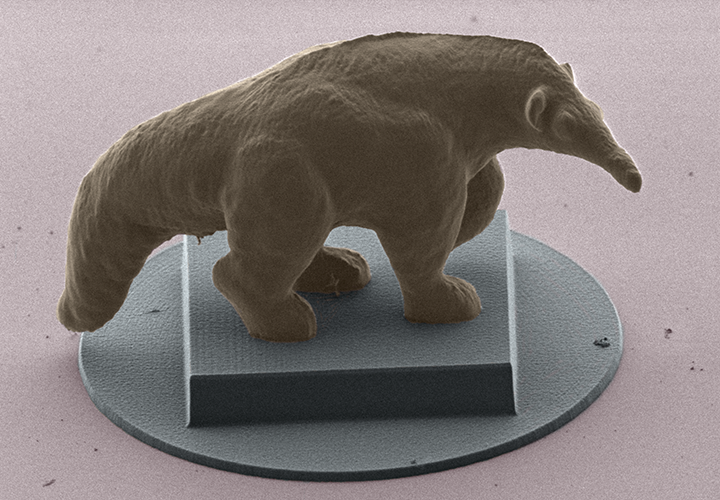Nanoscale Anteater Characterizes Bigger Picture
 Feb. 6, 2019 - UC Irvine’s quirky Anteater mascot comes in many sizes. From the 8 ft. tall human incarnation that cheers at basketball games to stuffed animals only inches high, Anteaters are a familiar sight on campus. Now, a novel, 3D-printed version breaks new ground; it could be the smallest Anteater ever – too small to be seen in detail with anything except a scanning electron microscope.
Feb. 6, 2019 - UC Irvine’s quirky Anteater mascot comes in many sizes. From the 8 ft. tall human incarnation that cheers at basketball games to stuffed animals only inches high, Anteaters are a familiar sight on campus. Now, a novel, 3D-printed version breaks new ground; it could be the smallest Anteater ever – too small to be seen in detail with anything except a scanning electron microscope.
The tiny mascot, which appears to the human eye to be a small dot, measures 60 microns in length and stands on a 30-micron-long base. (A micron is one-millionth of a meter. For comparison, a human hair is about 75-100 microns thick.) The miniature Anteater was printed on a Nanoscribe 3D printer, from an acrylate polymer, with a process called two-photon polymerization direct laser writing.
Lorenzo Valdevit, Samueli School materials science and engineering associate professor, researches mechanical metamaterials. This means he studies how to geometrically optimize the unit cells of periodic cellular materials in order to design novel materials with a unique combination of properties.
Valdevit says that the advent of two-photon polymerization direct laser writing, which he describes as “fancy, high-resolution stereolithography,” has allowed researchers to build new materials with nanoscale details. “You can print things of almost arbitrary complexity and fabricate very intricate objects in ways you cannot with traditional subtractive processes,” he adds.
Not that the tiny Anteater is particularly complex. “We don’t only use it to print Anteaters,” Valdevit quips of the high-resolution printer. “We use it to generate metamaterials that actually have remarkable properties.”
The nanoprinted Anteater itself was fashioned in Valdevit’s lab, but a collaborator in Clarksburg, Maryland, created the colorized SEM image. Eric J. Miller, from Hitachi High Technologies America, developed a new method for imaging these tiny polymeric constructions in an SEM. Because polymers are not electrically conductive, a metal coating can help maintain their composition when they’re bombarded by the electron beams of an SEM. But the coatings can change the mechanical properties of such small structures, so Miller developed a technique that eliminates the need for any metal. He is writing a chapter on this method for a textbook edited by a colleague of Valdevit’s (Tommaso Baldacchini, an expert in two-photon polymerization).
Miller asked Valdevit for samples to test his metal-free methods, and that’s when the UCI researcher got the idea to build a tiny 3D Anteater (he sent other samples, too).
The 3D process starts by depositing a drop of photo-sensitive resin, similar to those used in clean room microfabrication, onto a substrate. The substrate is placed on a stage that can move in three dimensions. A laser beam shoots photons at the material, starting the photo-polymerization process. Valdevit explains that using two photons instead of just one to initiate the reaction yields a much smaller-sized voxel, which means the geometries and details can be more precise. The samples can be printed by moving the laser inside the printing area, or by moving the stage and keeping the laser fixed.
While two-photon polymerization allows for printing materials at previously unthinkable scales, it still involves writing point by point, an extremely time-consuming process. The nanosized Anteater took about an hour to print, but something visible to the naked eye could take longer than a day, according to Valdevit.
Researchers are trying to figure out ways to scale up the technology. “That remains one of the biggest challenges,” Valdevit says. “For this technique to be impactful in structural materials, it would have to become 10,000 times faster.”
In the meantime, the tiny mascot has amassed a large distinction. “It may be the smallest Anteater ever printed,” says its creator.
- Anna Lynn Spitzer
